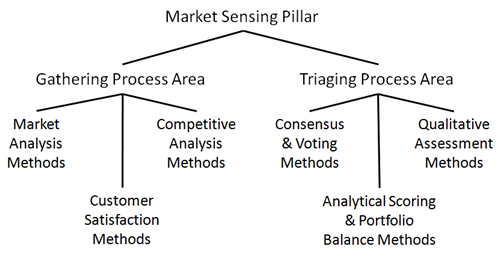Val Workman
The opinions expressed by the bloggers below and those providing comments are theirs alone, and do not necessarily reflect the opinions of Ryma Technology Solutions. As they say, you can't innovate without breaking a few eggs...
- Font size: Larger Smaller
- Hits: 49670
- 0 Comments
- Subscribe to this entry
- Bookmark
The Seven Pillars of Collaborative Product Management: Market Sensing
The Market Sensing Pillar's goal is to create your company's perception of the market. Everything your organization has done, is doing, and will do to formulate a perception of the market is market sensing. "Market" is one of those words everyone thinks they understand, but no two people state it the same. In keeping with one of the primary goals of the Seven Pillars of Collaborative Product Management (develop a common language), it’s only right for me to provide a definition here.
A market is the intersection of both the consumer, and the consumed. In a Cartesian grid, with the consumer being the columns and the consumed the rows, the ordered pair (consumed, consumer) represents a market. When this intersection is part of a larger set of intersections, then we call it a market segment.

In the above example, the consumers are listed as personas in the red cells of the table. Red cells can be personas, specific customer, sales territories, distribution channels, and so on. The green cells are the products and services being consumed. The green cells can be the complete offering, the physical offering, features of a product, technology and so on. Cells labeled A-I are the various markets or market segments defined by this table. The definition of market segments your organization should go after is normally conducted in the Opportunity Definition Pillar. The sensing of these markets is done within the Market Sensing Pillar.
An example of a market would be B (Trailer, Truck Driver/Owner) or G (Tractor, Grocery Chain Owners). Activities conducted to help perceive B, are referred to as market sensing activities, and are found within the Market Sensing Pillar. But before I get into the activities, I need to mention what I mean by "sensing".
"We've observed and understood"
When Market Sensing is done right, we've observed and understood. At a high level, sensing means to take in, apprehend, or gather with the mind or senses. Further inquiry yields to gather market evidence through one of the senses, or to become aware of that evidence by sight, hearing, touching, smelling, and/or tasting. Continuing on our inquiry, we find the additional concept of comprehension, and extend our definition to gather market evidence by observing them with the five senses and gain an understanding of this evidence. With a little more searching, we discover one more concept of the term; that of ownership apprehended and seized with the mind. My final definition of sensing is as follows: "To gain an understanding of market evidence through observing with the five senses to apprehend and seize this understanding of the market evidence with our minds."
To help us accomplish this vision of market sensing, we divide the Market Sensing Pillar into two process areas of Market Evidence Gathering, and Market Evidence Triaging. Yes, these process areas can be thought of as CMMI Process Areas.

Each of these processes areas contain methods for accomplishing the business objective of either Gathering or Triaging Market Evidence. We'll see later that some pillars have more than two process areas, but all have at least two.
With a little thought, you'll realize that there are hundreds of methods that could be used to gather and understand market evidence. It turns out that the same is true for triaging that evidence. Within the Gathering Process Area, there are three major types of strategies used to gather evidence. There's the methods that rely on market analysis, the methods that rely on competitive analysis, and the methods that rely on customer satisfaction. Within the Triaging Process Area, there are also three categories of methods shown in the illustration below.

As an example, I'll provide a list of a few methods contained within some of these categories. Within market analysis you would find Customer Visits, Market Segmentation, Driving Force Analysis, Creativity Events, Personas, and so on. Within Competitive Analysis you'd find Win Loss Reports, SWOT Analysis, Benchmark Analysis, Kano Analysis and so on.








